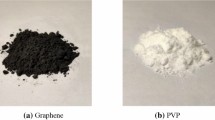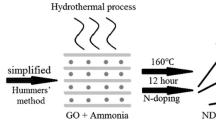Abstract
Highly stable graphene oxide (GO)-based nanofluids were simply prepared by dispersing graphite oxide with the average crystallite size of 20 nm, in polar base fluids without using any surfactant. Electrical conductivity, thermal conductivity, and rheological properties of the nanofluids were measured at different mass fractions and various temperatures. An enormous enhancement, 25,678 %, in electrical conductivity of distilled water was observed by loading 0.0006 mass fraction of GO at 25 °C. GO–ethylene glycol nanofluids exhibited a non-Newtonian shear-thinning behavior followed by a shear-independent region. This shear-thinning behavior became more pronounced at higher GO concentrations. The maximum ratio of the viscosity of nanofluid to that of the ethylene glycol as a base fluid was 3.4 for the mass fraction of 0.005 of GO at 20 °C under shear rate of 27.5 s−1. Thermal conductivity enhancement of 30 % was obtained for GO–ethylene glycol nanofluid for mass fraction of 0.07. The measurement of the transport properties of this new kind of nanofluid showed that it could provide an ideal fluid for heat transfer and electronic applications.









Similar content being viewed by others
References
Abareshi M, Goharshadi EK, Mojtaba Zebarjad S, Khandan Fadafan H, Youssefi A (2010) Fabrication, characterization and measurement of thermal conductivity of Fe3O4 nanofluids. J Magn Magn Mater 322:3895–3901. doi:10.1016/j.jmmm.2010.08.016
Acik M, Chabal YJ (2012) A review on reducing graphene oxide for band gap engineering. J Mater Sci Res 2:101
Amato G (1991) A new approach in the optical characterization of amorphous hydrogenated silicon-carbon alloys. Phys Status Solidi (b) 165:623–634
Azizi-Toupkanloo H, Goharshadi EK, Nancarrow P (2014) Structural, electrical, and rheological properties of palladium/silver bimetallic nanoparticles prepared by conventional and ultrasonic-assisted reduction methods. Adv Powder Technol 25:801–810. doi:10.1016/j.apt.2013.11.015
Baby TT, Ramaprabhu S (2010) Investigation of thermal and electrical conductivity of graphene based nanofluids. J Appl Phys 108:124308. doi:10.1063/1.3516289
Baby TT, Ramaprabhu S (2011) Synthesis and nanofluid application of silver nanoparticles decorated graphene. J Mater Chem 21:9702–9709. doi:10.1039/c0jm04106h
Boukhvalov DW, Katsnelson MI (2008) Modeling of graphite oxide. J Am Chem Soc 130:10697–10701. doi:10.1021/ja8021686
Brodie B (1860) Sur le poids atomique du graphite. Ann de chim et de phys 59:466–472
Cancado L et al (2006) General equation for the determination of the crystallite size L a of nanographite by Raman spectroscopy. Appl Phys Lett 88:163106
Carrique F, Ruiz-Reina E (2009) Electrical conductivity of aqueous salt-free concentrated suspensions. Effects of water dissociation and CO2 contamination. J Phys Chem B 113:10261–10270
Chakraborty S, Padhy S (2008) Anomalous electrical conductivity of nanoscale colloidal suspensions. ACS Nano 2:2029–2036. doi:10.1021/nn800343h
Chen L, Xie H (2009) Silicon oil based multiwalled carbon nanotubes nanofluid with optimized thermal conductivity enhancement. Colloids Surf A 352:136–140
Chen S, Zhu J, Huang H, Zeng G, Nie F, Wang X (2010) Facile solvothermal synthesis of graphene–MnOOH nanocomposites. J Solid State Chem 183:2552–2557
Dimiev AM, Alemany LB, Tour JM (2012) Graphene oxide. Origin of acidity, its instability in water, and a new dynamic structural model. ACS Nano 7:576–588. doi:10.1021/nn3047378
Dong M, Shen LP, Wang H, Wang HB, Miao J (2013) Investigation on the electrical conductivity of transformer oil-Based AlN nanofluid. J Nano Mater 2013:7. doi:10.1155/2013/842963
El Achaby M, Arrakhiz FZ, Vaudreuil S, Essassi EM, Qaiss A (2012) Piezoelectric β-polymorph formation and properties enhancement in graphene oxide—PVDF nanocomposite films. Appl Surf Sci 258:7668–7677. doi:10.1016/j.apsusc.2012.04.118
Ganguly S, Sikdar S, Basu S (2009) Experimental investigation of the effective electrical conductivity of aluminum oxide nanofluids. Powder Technol 196:326–330
Glory J, Bonetti M, Helezen M, Mayne-L’Hermite M, Reynaud C (2008) Thermal and electrical conductivities of water-based nanofluids prepared with long multiwalled carbon nanotubes. J Appl Phys. doi:10.1063/1.2908229
Glover B, Whites KW, Hong H, Mukherjee A, Billups WE (2008) Effective electrical conductivity of functional single-wall carbon nanotubes in aqueous fluids. Synth Met 158:506–508. doi:10.1016/j.synthmet.2008.03.022
Goharshadi EK, Azizi-Toupkanloo H (2013a) Silver colloid nanoparticles: ultrasound-assisted synthesis, electrical and rheological properties. Powder Technol 237:97–101. doi:10.1016/j.powtec.2012.12.059
Goharshadi EK, Azizi-Toupkanloo H (2013b) Silver colloid nanoparticles: ultrasound-assisted synthesis, electrical and rheological properties. Powder Technol 237:97–101
Goharshadi EK, Hadadian M (2012) Effect of calcination temperature on structural, vibrational, optical, and rheological properties of zirconia nanoparticles. Ceram Int 38:1771–1777. doi:10.1016/j.ceramint.2011.09.063
Goharshadi EK, Ahmadzadeh H, Samiee S, Hadadian M (2013) Nanofluids for heat transfer enhancement–A review. Phys Chem Res 1:1–33
Goncalves G, Marques PA, Granadeiro CM, Nogueira HI, Singh M, Gracio J (2009) Surface modification of graphene nanosheets with gold nanoparticles: the role of oxygen moieties at graphene surface on gold nucleation and growth. Chem Mater 21:4796–4802
Hunter RJ (1981) Zeta potential in colloid science: principles and applications, vol 125. Academic press, London
Jain S, Patel H, Das S (2009) Brownian dynamic simulation for the prediction of effective thermal conductivity of nanofluid. J Nanopart Res 11:767–773. doi:10.1007/s11051-008-9454-4
Jang SP, Choi SUS (2004) Role of Brownian motion in the enhanced thermal conductivity of nanofluids. Appl Phys Lett 84:4316. doi:10.1063/1.1756684
Jung I et al (2009) Reduction kinetics of graphene oxide determined by electrical transport measurements and temperature programmed desorption. J Phys Chem C 113:18480–18486. doi:10.1021/jp904396j
Kang D-W, Shin H-S (2012) Control of size and physical properties of graphene oxide by changing the oxidation temperature. Carbon Lett 13:39–43
Kolbe J, Arp A, Calderone F, Meyer EM, Meyer W, Schaefer H, Stuve M (2007) Inkjettable conductive adhesive for use in microelectronics and microsystems technology. Microelectron Reliab 47:331–334
Kole M, Dey T (2010) Thermal conductivity and viscosity of Al2O3 nanofluid based on car engine coolant. J Phys D 43:315501
Kole M, Dey TK (2013) Investigation of thermal conductivity, viscosity, and electrical conductivity of graphene based nanofluids. J Appl Phys. doi:10.1063/1.4793581
Krishnamoorthy K, Veerapandian M, Yun K, Kim S-J (2013) The chemical and structural analysis of graphene oxide with different degrees of oxidation. Carbon 53:38–49
Kumar CMP, Venkatesha TV, Shabadi R (2013) Preparation and corrosion behavior of Ni and Ni–graphene composite coatings. Mater Res Bull 48:1477–1483. doi:10.1016/j.materresbull.2012.12.064
Kumar PV, Bardhan NM, Tongay S, Wu J, Belcher AM, Grossman JC (2014) Scalable enhancement of graphene oxide properties by thermally driven phase transformation. Nat Chem 6:151–158. doi:10.1038/nchem.1820
Lee JW, Ko JM, Kim J-D (2012) Hydrothermal preparation of nitrogen-doped graphene sheets via hexamethylenetetramine for application as supercapacitor electrodes. Electrochim Acta 85:459–466. doi:10.1016/j.electacta.2012.08.070
Lerf A, He H, Forster M, Klinowski J (1998) Structure of graphite oxide revisited. J Phys Chem b 102:4477–4482
Li H, Zhao Q, Li X, Zhu Z, Tade M, Liu S (2013) Fabrication, characterization, and photocatalytic property of α-Fe2O3/graphene oxide composite. J Nanopart Res 15:1–11. doi:10.1007/s11051-013-1670-x
Lide DR (2000) CRC handbook of chemistry and physics, 74th edn. CRC Press, Boca Raton
Loh KP, Bao Q, Eda G, Chhowalla M (2010) Graphene oxide as a chemically tunable platform for optical applications. Nat Chem 2:1015–1024
Long D, Li W, Ling L, Miyawaki J, Mochida I, Yoon S-H (2010) Preparation of nitrogen-doped graphene sheets by a combined chemical and hydrothermal reduction of graphene oxide. Langmuir 26:16096–16102. doi:10.1021/la102425a
Ma W, Yang F, Shi J, Wang F, Zhang Z, Wang S (2013) Silicone based nanofluids containing functionalized graphene nanosheets. Colloids Surf A 431:120–126. doi:10.1016/j.colsurfa.2013.04.031
Malard LM, Pimenta MA, Dresselhaus G, Dresselhaus MS (2009) Raman spectroscopy in graphene. Phys Rep 473:51–87. doi:10.1016/j.physrep.2009.02.003
Marcano DC et al (2010) Improved synthesis of graphene oxide. ACS Nano 4:4806–4814. doi:10.1021/nn1006368
Maxwell JC (1904) A treatise on electricity and magnetism vol 1, 3rd edn. Clarendon, Oxford
Mehrali M, Sadeghinezhad E, Latibari ST, Kazi SN, Mehrali M, Zubir MNBM, Metselaar HSC (2014) Investigation of thermal conductivity and rheological properties of nanofluids containing graphene nanoplatelets. Nanoscale Res Lett 9:1–12
Minea A, Luciu R (2012) Investigations on electrical conductivity of stabilized water based Al2O3 nanofluids. Microfluid Nanofluid 13:977–985. doi:10.1007/s10404-012-1017-4
Moghaddam MB, Goharshadi EK, Entezari MH, Nancarrow P (2013) Preparation, characterization, and rheological properties of graphene–glycerol nanofluids. Chem Eng J 231:365–372
Moosavi M, Goharshadi EK, Youssefi A (2010) Fabrication, characterization, and measurement of some physicochemical properties of ZnO nanofluids. Int J Heat Fluid Flow 31:599–605
Nan C-W, Birringer R, Clarke DR, Gleiter H (1997) Effective thermal conductivity of particulate composites with interfacial thermal resistance. J Appl Phys 81:6692. doi:10.1063/1.365209
Nika DL, Pokatilov EP, Askerov AS, Balandin AA (2009) Phonon thermal conduction in graphene: role of umklapp and edge roughness scattering. Phys Rev B 79:155413
Park S, Ruoff RS (2009) Chemical methods for the production of graphenes. Nat Nano 4:217–224
Patel H, Sundararajan T, Das S (2010) An experimental investigation into the thermal conductivity enhancement in oxide and metallic nanofluids. J Nanopart Res 12:1015–1031. doi:10.1007/s11051-009-9658-2
Pimenta M, Dresselhaus G, Dresselhaus MS, Cancado L, Jorio A, Saito R (2007) Studying disorder in graphite-based systems by Raman spectroscopy. PCCP 9:1276–1290
Radović M, Dohčević-Mitrović Z, Golubović A, Fruth V, Preda S, Šćepanović M, Popović ZV (2013) Influence of Fe3+-doping on optical properties of CeO2−y nanopowders. Ceram Int 39:4929–4936. doi:10.1016/j.ceramint.2012.11.087
Ruan B, Jacobi A (2012) Ultrasonication effects on thermal and rheological properties of carbon nanotube suspensions. Nanoscale Res Lett 7:1–14. doi:10.1186/1556-276X-7-127
Salehi J, Heyhat M, Rajabpour A (2013) Enhancement of thermal conductivity of silver nanofluid synthesized by a one-step method with the effect of polyvinylpyrrolidone on thermal behavior. Appl Phys Lett 102:231907
Sarojini KGK, Manoj SV, Singh PK, Pradeep T, Das SK (2013) Electrical conductivity of ceramic and metallic nanofluids. Colloids Surf A 417:39–46. doi:10.1016/j.colsurfa.2012.10.010
Shao G, Lu Y, Wu F, Yang C, Zeng F, Wu Q (2012) Graphene oxide: the mechanisms of oxidation and exfoliation. J Mater Sci 47:4400–4409
Shen L, Wang H, Dong M, Ma Z, Wang H (2012) Solvothermal synthesis and electrical conductivity model for the zinc oxide-insulated oil nanofluid. Phys Lett A 376:1053–1057
Shih C-J, Lin S, Sharma R, Strano MS, Blankschtein D (2011) Understanding the pH-dependent behavior of graphene oxide aqueous solutions: a comparative experimental and molecular dynamics simulation study. Langmuir 28:235–241
Solomon I, Schmidt MP, Sénémaud C, Driss Khodja M (1988) Band structure of carbonated amorphous silicon studied by optical, photoelectron, and x-ray spectroscopy. Phys Rev B 38:13263–13270
Sun L et al (2012) Nitrogen-doped graphene with high nitrogen level via a one-step hydrothermal reaction of graphene oxide with urea for superior capacitive energy storage. RSC Advances 2:4498–4506. doi:10.1039/C2RA01367C
Tesfai W, Singh P, Shatilla Y, Iqbal M, Abdala A (2013) Rheology and microstructure of dilute graphene oxide suspension. J Nanopart Res 15:1–7. doi:10.1007/s11051-013-1989-3
Tuinstra F (1970) Raman spectrum of graphite. J Chem Phys 53:1126. doi:10.1063/1.1674108
Wang B, Wang X, Lou W, Hao J (2012a) Thermal conductivity and rheological properties of graphite/oil nanofluids. Colloids Surf A 414:125–131. doi:10.1016/j.colsurfa.2012.08.008
Wang D-W, Du A, Taran E, Lu GQ, Gentle IR (2012b) A water-dielectric capacitor using hydrated graphene oxide film. J Mater Chem 22:21085. doi:10.1039/c2jm34476a
White SB, Shih AJ-M, Pipe KP (2011) Investigation of the electrical conductivity of propylene glycol-based ZnO nanofluids. Nanoscale Res Lett 6:1–5
Wojtoniszak M, Mijowska E (2012) Controlled oxidation of graphite to graphene oxide with novel oxidants in a bulk scale. J Nanopart Res 14:1–7. doi:10.1007/s11051-012-1248-z
Wu Z-S, Ren W, Gao L, Liu B, Jiang C, Cheng H-M (2009) Synthesis of high-quality graphene with a pre-determined number of layers. Carbon 47:493–499. doi:10.1016/j.carbon.2008.10.031
Yeganeh M, Shahtahmasebi N, Kompany A, Goharshadi E, Youssefi A, Šiller L (2010) Volume fraction and temperature variations of the effective thermal conductivity of nanodiamond fluids in deionized water. Int J Heat Mass Transf 53:3186–3192
Yin D et al (2013) Functional graphene oxide as a plasmid-based Stat3 siRNA carrier inhibits mouse malignant melanoma growth in vivo. Nanotechnology 24:105102
Yu W, Xie H, Bao D (2010a) Enhanced thermal conductivities of nanofluids containing graphene oxide nanosheets. Nanotechnology 21:055705
Yu W, Xie H, Chen W (2010b) Experimental investigation on thermal conductivity of nanofluids containing graphene oxide nanosheets. J Appl Phys 107:094317
Yu W, Xie H, Wang X, Wang X (2011) Significant thermal conductivity enhancement for nanofluids containing graphene nanosheets. Phys Lett A 375:1323–1328. doi:10.1016/j.physleta.2011.01.040
Acknowledgments
The authors would like to express their gratitude to Ferdowsi University of Mashhad for support of this project (Grant no. 3/29228).
Author information
Authors and Affiliations
Corresponding author
Rights and permissions
About this article
Cite this article
Hadadian, M., Goharshadi, E.K. & Youssefi, A. Electrical conductivity, thermal conductivity, and rheological properties of graphene oxide-based nanofluids. J Nanopart Res 16, 2788 (2014). https://doi.org/10.1007/s11051-014-2788-1
Received:
Accepted:
Published:
DOI: https://doi.org/10.1007/s11051-014-2788-1




